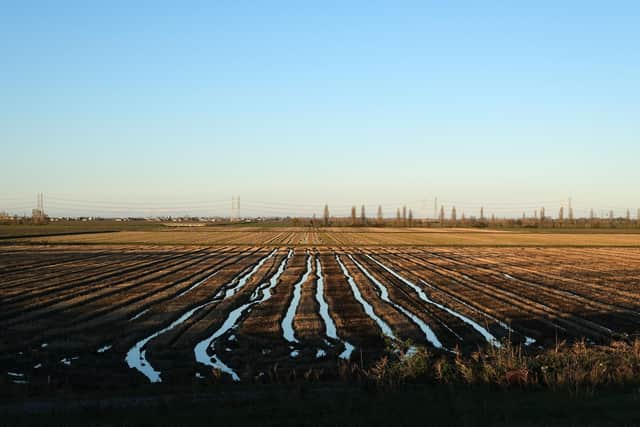Italy's 'land without animals' reveals something sinister behind its famously passionate relationship with food – Philip Lymbery
I marveled at the pretty villages with picturesque churches and hilly backdrops. The endless pastures and crop fields. The balmy days of blue skies and t-shirt temperatures. Friendly people at every turn. And the smell of the most delicious food.
No wonder the country is so widely cited as the world’s number one for cuisine. Whether pizzas, pastas or gnocchi served with a myriad of flavours, Italy seems to have it all. Its food engenders an exhilaration like no other; what world-renowned Italian chef Giorgio Locatelli describes as “the relationship between food, sex, wine and the excitement of life”.
Advertisement
Hide AdAdvertisement
Hide AdExcept, there was something missing. In my days traversing the fields, valleys and plains of the rich Italian countryside, I never once saw a farm animal outside. It was an irony that has stayed with me ever since.
Where were the cows producing milk for world-famous Parmesan or Grana Padano? Or the pigs renowned for Parma ham? Or the chickens producing eggs for Carbonara?
Quality not quantity
What I discovered is that farmers in Italy’s richest agricultural region had forgotten how to keep animals outside. They simply had a blind spot. They couldn’t see why it wasn’t right to keep them cooped up indoors all day, every day. They couldn’t see the irony of grass being grown then mowed and packed into bales to feed incarcerated cows.
They had lost sight of the fact that cows, pigs, and chickens like to feel fresh air and sunshine as much as we do. It put me in mind of something else Locatelli once said: “It is better to have fantastic meat once a week than fill ourselves up every day with cheap, carelessly reared meat. We all have to get used to quality, not quantity.”


The most surprising discovery on my travels through the Italian countryside was the way dairy cows were kept, not least for those world-renowned iconic cheeses of Parmesan and Grana Padano. I remember checking the production details for Parmesan and Grana Padano and finding they both mentioned the cows being raised on fresh grass and hay.
But cows wandering the fields, gently tugging at grassy stalks or chewing the cud under the shade of trees, were conspicuous by their absence; the only cows I could find were crammed into darkened sheds. I remember seeing about 100 cows peering out of a single square shed. They were trapped inside but had a perfect view of the lush pasture they were prevented from grazing on.
I watched incredulously as heavy goods vehicles delivered grass to a processing plant. A yellow tractor scooped grass into a giant machine, while yet more trucks took compacted blocks of grass and drove them away. Instead of letting the animals graze in a time-honoured fashion, mechanically pressed bales were being produced to feed confined cattle.
Zero grazing for cows
In what should have been a cow’s paradise, nature’s way had been abandoned. According to the Grana Padano consortium, 80 per cent of their cows are denied pasture access with approximately 40 per cent confined indoors, not even having outdoor ‘paddocks’. It reinforced my impression that we now have a generation of cattle farmers in Italy that simply don’t know how to keep animals as nature intended – on pasture.
Advertisement
Hide AdAdvertisement
Hide AdI wondered whether things were now different for those cows milked for Parmesan – or Parmigiano Reggiano to give its full name. Surely, this ‘king of cheeses’ would be made from the milk of cows that are kept on grass? Like Grana Padano and many other regional foods, strict rules govern the manufacture of Parmesan. Given its protected status, only cheesemakers from Parma, Reggio Emilia, parts of Bologna, Modena and Mantua can qualify.
My enquiries, in 2016, to the Consorzio del Formaggio Parmigiano Reggiano, the consortium that governs the manufacture of Parmesan, resulted in them sharing that the proportion of cows grazing freely in fields for them during the summer months was “very low”. I was told that there were few exceptions, perhaps as few as one per cent of their farms had cows out grazing. In 2023, I asked them for an update and received no reply.
Known as ‘zero grazing’ – keeping cows indoors permanently – I subsequently found that it was common practice all over Italy. As Kees de Roest wrote in his book, The Production of Parmigiano-Reggiano Cheese: The Force of an Artisanal System in an Industrialised World, "almost all Italian dairy farms apply the zero-grazing system”.
A strange landscape
Whilst cows are confined indoors, Italy’s crop fields are often dedicated to growing feed for them rather than food for people. About half of Italy’s cereal crop is used to feed intensively reared animals. In addition, the country is a big importer of soya, bringing in about three million tonnes a year, much of which is used to feed industrially reared animals.
Farmed animals are now spookily conspicuous by their absence from the fields and valleys of Italy’s Po Valley. This reminded me of those prophetic words by Italian chef, Giorgio Locatelli who warned against eating cheap, carelessly reared meat and urged us to choose quality over quantity.
Putting quality back on our plate seems the right ingredient for ensuring that Italian cuisine once again reflects that fabled relationship between food, sex, wine and the excitement of life. Saying ‘arrivederci’ to keeping cows permanently indoors should be a big part of a recipe for nature-friendly food for the future.
Philip Lymbery is chief executive of Compassion in World Farming, a former United Nations Food Systems Champion and award-winning author of Farmageddon: The True Cost of Cheap Meat; Dead Zone: Where the Wild Things Were; and Sixty Harvests Left: How to Reach a Nature-Friendly Future. He is on Twitter @philip_ciwf
Comments
Want to join the conversation? Please or to comment on this article.
